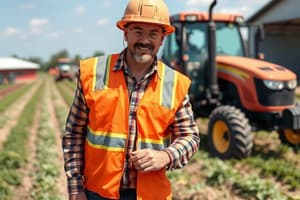Podcast
Questions and Answers
Match the farm safety hazard with its description:
Match the farm safety hazard with its description:
Kicks, bites, or diseases from animals = Physical harm from livestock Falls from high places = Injuries from falling off elevated surfaces Crushes from farm vehicles = Accidents involving machinery on the farm Exposure to chemicals = Risk from handling toxic substances
Match the at-risk group with the associated risks:
Match the at-risk group with the associated risks:
Children = 10% of farm fatalities Older farmers = Accidents caused by livestock or machinery due to limited capabilities Farmers = Responsible for ensuring farm safety standards All individuals on the farm = Should follow a risk assessment plan
Match the safety practice with its description:
Match the safety practice with its description:
Having a risk assessment plan = Identifying risks on the farm Supervising children at all times = Preventing farm fatalities Placing farm signage around highlighting hazards = Increasing awareness of dangers Locking away all chemicals from children = Preventing access to toxic substances
Match the farm safety concern with the precaution:
Match the farm safety concern with the precaution:
Match the physical factors with the risks for older farmers:
Match the physical factors with the risks for older farmers:
Match the safety measure with its goal:
Match the safety measure with its goal:
Match the recommended practice with its purpose:
Match the recommended practice with its purpose:
Match the farm safety concern with the potential consequence:
Match the farm safety concern with the potential consequence:
Match the farm safety measure with its purpose:
Match the farm safety measure with its purpose:
Match the at-risk group with the associated vulnerability:
Match the at-risk group with the associated vulnerability:
Match the farm safety practice with its recommended action:
Match the farm safety practice with its recommended action:
Match the potential farm safety hazard with its preventative measure:
Match the potential farm safety hazard with its preventative measure:
Match the physical factors affecting older farmers with their impact on safety:
Match the physical factors affecting older farmers with their impact on safety:
Match the recommended safety behavior with its justification:
Match the recommended safety behavior with its justification:
Flashcards are hidden until you start studying




